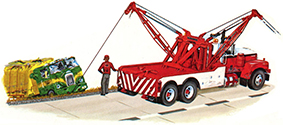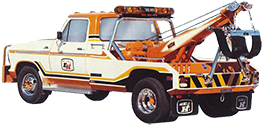 |
 The History of Holmes Wreckers |
 |
| History | Models | Identification | Links | Contact Us |
HOLMES RAIL ROAD CRANES
Two 850 Wreckers for the railroad crane project were demonstrated in handling railroad equipment for rerailing.
The first one was the B & O Railroad in Baltimore, MD.
The second one was at Atcheson, Topeka and the Santa Fe yard in Clovis, New Mexico.
The demonstrators did not do the job they expected. They could lift the load but would not swing.
That night Jerry Holmes and Bob Freeman left the demonstration they went to a bar in Clovis and drew on a napkin the concept of what was needed in the railroad wrecking crane. So the RC – 50 was in the planning stage.
The first two experimental cranes No. 101 & 102 were mounted on a three man cab on Crane Carrier chassis. They were equipped with Cox-High Rail equipment. This proved to be somewhat satisfactory.
The railroads started building heavier and larger cars to handle bigger loads so they had to upgrade the RC – 50 Railroad Crane.
In 1969 Frank went to work for the Ernest Holmes Company as Manager of the Railroad Crane Division. He was in charge of selling, delivery, and service for the cranes. He was also the trouble shooter for the company.
There were times he found himself alone in a railroad yard at night in a rough neighborhood. Sometimes the railroad company would take him out for a meal. But he was usually on his own.
He always found out the problem and got the parts to get them back in operation.
He later got help in his department, Richard D. Healy and Guion Kropp on the road, and Peggy Washington as first secretary. Wayne Ervin later came as assistant manager and Donnie King and Maurice (Mote) Sliger as service men.
Stephen L. Akey from Nixon Detroit Diesel sold Ernest Holmes Company the engines for the cranes.
Mr W.A. Beasley chose Mr F. Vaughn Cannon to assist him designing new features and larger capacity cranes for the railroad crane department.
RC 50 RAILROAD CRANE
First 3 / 24 / 1969 ~ 17 Built
No. 103 First one sold to Excelsior Truck Leasing in Philadelphia, PA
The first two were experimental ~ CODE CE
| B69CE-103 | Excelsior Truck Leasing Philadelphia, PA | 3/24/1969 |
| B69CE-104 | Excelsior Truck Leasing Philadelphia, PA | 3/27/1969 |
| B69CE-105 | Union Pacific Railroad | 7/01/1969 |
| B69CE-106 | Excelsior Truck Leasing | 4/07/1969 |
| B69CE-107 | Union Pacific Railroad | 12/16/1969 |
| B69CE-108 | Union Pacific Railroad | 1/05/1970 |
| A 70-CE-109 | Excelsior Truck Leasing | 1/12/1970 |
| B 70-CE-110 | Excelsior Truck Leasing | 2/03/1970 |
| B 70-CE -111 | Excelsior Truck Leasing | 2/16/1970 |
| B 70-CE-112 | Excelsior Truck Leasing | 3/05/1970 |
| C 70-CE-113 | Excelsior Truck Leasing | 3/17/1970 |
| C 70-CE-114 | Saint Louis-San Francisco Railway | 4/01/1970 |
| C 70-CE-115 | Union Pacific Railroad | 4/09/1970 |
| D 70-CE-116 | Union Pacific Railroad | 4/23/1970 |
| E 70-CE-117 | Excelsior Truck Leasing | 5/18/1970 |
The first RC – 50 was mounted on a FWD Chassis.
B69CE-101 and B69CD-102 were experimental cranes.
They were later sold to Excelsior Truck Leasing and went to the New York Central Railway.





RC-60 RAILROAD CRANE
60 TON 1972
The railroads started building heavier engines and larger cars to handle bigger loads so Ernest Holmes Company had to upgrade the RC–50.
The Rotec ring had to be heavier. The boom was upgraded to stronger steel and the lifting block was heavier.
This upgrade then changed the name from a RC–50 to RC-60.
The serial numbers were continued from the RC-50 except the code changed to DF.
One (1) RC-60 was sold to the Bay Area Transit in Oakland, CA. This was a special unit built for wide gauge rail 66”, with flotation on all wheels.
It is not clear how many of the RC-60’s were built.








RC-75 RAILROAD CRANE
150,000 pound capacity
There were five of these built; the first one was made in 1975
The first RC-75 went to the Milwaukee Rail Yard in Milwaukee, WI.
The crane was being shipped by Southern Railway to Milwaukee. In Cincinnati, OH, it was in the Southern Railway Yard at night and someone took a ball bat and broke all the windows. The man was caught and sent to jail and was told to pay for the damages. In the meantime the Southern Railway had all the windows replaced and sent the crane on to the Milwaukee Railroad.
The next three went to Morocco in Africa.
The 5th one went to the Canadian National Railroad in Winnipeg, Canada.
The serial number was continued from the RC-60 except the code changed to ED.
Railroad Crane Codes:
CE - RC-50
DF - RC-60
ED - RC-75
EA - RC-100




RC-100 RAILROAD CRANES
100 TON 200,000 POUND
This crane was called “Bicentennial” because the first one was made in in 1976, They were manufactured from 1976-1982.
The first one was painted red, white and blue and sold to Pennsylvania Erection and Rigging Co. in Turtle Creek, PA.
The serial number was continued from the RC-75 except the code was EA.
There were several different ways the RC-100 were made.
In Brazil they bought (5) RC-100. They bought two for standard rail and (1) for narrow gauge rail for the Brazilian Railroad. The Brazilian State owned Steel Mill also bought (2) of the standard gauge. On the narrow gauge it was special built propelled by the inside duals on the rail. The standard boom was modified for the Brazilian State owned Steel Mill. They were going to use them to pick up scrap steel. The boom was 25’ and to get the height they needed to lift the steel with the magnet they had to add an 8’ extension into the boom. The extension could be removed for more capacity on the crane for rerailing. The crane itself was used for rerailing cars full of molted steel which weighed approximately 100 ton.
The cranes were equipped with Fairmont Heavy duty rail units w/air brakes. The cab was a Crane Carrier Co. CCC4 Man Centurion cab with manual hydraulic tilt.
There were two RC-100’s sold to Con-Rail; one to Lyle Brothers in Vidor, Texas and two to Donahue Brothers, in Barbarsville, West, Va. One also went to South Africa, the South African Rails, a narrow gauge 42” rail unit.
The railroads did not want any pictures taken of any train derailment because it was bad publicity for them.












THE END
The railroad crane department was sold to Kershaw Co, in Montgomery, Alabama in 1982.
They demanded all literature, pictures, brochures, and everything concerning the railroad crane to be turned over to them. They ran back and forth for two weeks taking crane parts, assemblies, and sub-assemblies.
Frank Thomas and Gary Roberts worked with the Kershaw people to gather all parts and supplies pertaining to the railroad crane. They gathered in three separate sections enough parts to build three (3) RC-100 Railroad cranes. Then all the other parts were inventoried and shipped by truck loads to Kershaw and put on consignment. After three years they decided they did not want the parts and wanted them out of inventory. Frank was sent to Montgomery to inventory all parts that were left which had the approximate value of $500,000 cost. These were sold for scrap to Sable Steel in Montgomery for $3,235.00.
That was the end of the Ernest Holmes Company Railroad Cranes.
Information provided by Frank Thomas. Source - Towing Museum Chattanooga
The Holmes Railroad Crane line started in 1969 and finished with the sale of the line (including parts and drawings to Kershaw in 1982. It is estimated that about 75 units were built – most of which were RC-100’s between 1976 and 1982.
They were replaced in the market by hydraulic units as hydraulic cranes took over the crane market. Some of the Holmes cranes are still in service: Kirby Grant has a very nice RC-100 that is used in heavy lift service. There is also an RC-50 on display at the “Roots of Motive Power” Railroad Museum in Willits, California.
We are looking for serial number records on these cranes: if you have one – or any serial number records please contact Alex Millar – z77@shaw.ca
Below are the ads from Railroad Age,Progressive Railroading and Modern Railroading trade magazines that Holmes used to promote these cranes in the 60's and 70's. It is interesting in the "increased capacity" ad they listed the regular Holmes zone managers as the contact person. These ads were hard to find as these magazines were for the trade only and not widely distributed. |
|
| History | Models | Identification | Links | Contact Us |





